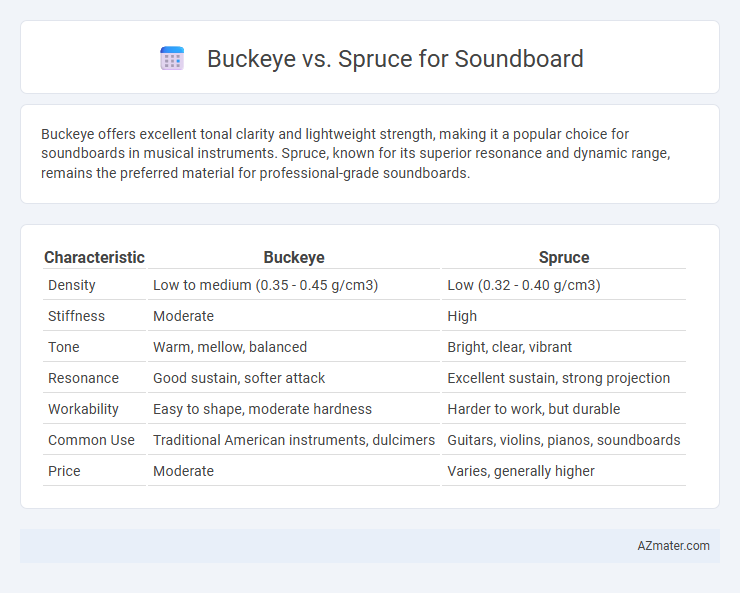Buckeye offers excellent tonal clarity and lightweight strength, making it a popular choice for soundboards in musical instruments. Spruce, known for its superior resonance and dynamic range, remains the preferred material for professional-grade soundboards.
Table of Comparison
| Characteristic | Buckeye | Spruce |
|---|---|---|
| Density | Low to medium (0.35 - 0.45 g/cm3) | Low (0.32 - 0.40 g/cm3) |
| Stiffness | Moderate | High |
| Tone | Warm, mellow, balanced | Bright, clear, vibrant |
| Resonance | Good sustain, softer attack | Excellent sustain, strong projection |
| Workability | Easy to shape, moderate hardness | Harder to work, but durable |
| Common Use | Traditional American instruments, dulcimers | Guitars, violins, pianos, soundboards |
| Price | Moderate | Varies, generally higher |
Introduction to Soundboard Wood Choices
Buckeye and Spruce are popular soundboard wood choices known for their tonal qualities and responsiveness. Buckeye offers a unique combination of light weight and moderate stiffness, producing warm, balanced resonance, while Spruce, especially Sitka Spruce, is renowned for its high strength-to-weight ratio, delivering bright, dynamic sound with excellent projection. Both woods are favored by luthiers for their ability to enhance a guitar's overall tonal clarity and sustain.
Overview: Buckeye and Spruce Tonewoods
Buckeye and Spruce are popular tonewoods used for guitar soundboards, each offering distinct acoustic qualities. Buckeye, known for its dense grain structure, produces a warm, rich tone with enhanced midrange frequencies and excellent sustain. Spruce, favored for its light weight and stiff cellular makeup, delivers a bright, clear sound with strong projection and dynamic range, making it the preferred choice for many professional luthiers.
Acoustic Properties of Buckeye
Buckeye wood possesses excellent acoustic properties, characterized by its balanced density and fine grain, making it ideal for soundboards. Its natural resonance enhances tonal clarity and sustain, delivering warm, rich sounds favored by luthiers. Compared to spruce, buckeye offers a unique tonal warmth and a slightly softer attack, appealing to musicians seeking distinctive acoustic qualities.
Acoustic Properties of Spruce
Spruce is highly valued for soundboards due to its exceptional acoustic properties, including a high stiffness-to-weight ratio that enhances sound projection and resonance. Its tight, straight grain structure allows for superior vibrational response and tonal clarity, making it a preferred choice for musical instruments like guitars and pianos. In contrast, Buckeye, while dense, lacks the same balance of flexibility and strength, resulting in less efficient sound transmission and a darker tonal quality.
Durability and Longevity Comparison
Buckeye wood offers superior durability for soundboards due to its dense grain structure, providing long-lasting resistance against wear and environmental factors. Spruce, widely favored for its balance of strength and lightweight properties, maintains excellent longevity when properly maintained but is generally more susceptible to dents and moisture damage than Buckeye. Both woods excel in acoustic performance, yet Buckeye's toughness often ensures extended lifespan in demanding musical settings.
Visual Appeal: Grain and Finish Differences
Buckeye showcases a complex, swirling grain pattern with varied coloration, giving soundboards a striking, organic aesthetic that stands out under transparent finishes. Spruce features a straight, fine grain with a consistent, light tone, delivering a clean and classic look that enhances brightness and clarity in soundboards. The difference in grain texture and color depth between Buckeye and Spruce significantly impacts the visual appeal, with Buckeye providing a more dramatic, textured finish and Spruce offering elegance and simplicity.
Workability for Luthiers
Buckeye offers excellent workability for luthiers due to its fine, uniform grain and moderate hardness, allowing for clean cuts and easy shaping on soundboards. Spruce remains the preferred choice because of its exceptional strength-to-weight ratio and responsiveness, though it can be slightly more challenging to work with due to its softer, more fibrous texture. Luthiers value Buckeye when seeking a durable, workable alternative that still maintains desirable acoustic properties.
Influence on Sound Quality and Tone
Buckeye and spruce are two popular tonewoods used in soundboard construction, each influencing sound quality and tone distinctly. Spruce, especially Sitka and Engelmann varieties, produces bright, clear, and responsive tones with excellent projection and dynamic range, making it a preferred choice for many acoustic instruments. Buckeye, on the other hand, offers a warmer, more balanced tonal quality with enhanced midrange frequencies, providing a unique sound character favored in niche or vintage-style instruments.
Cost and Availability
Buckeye wood offers a cost-effective option for soundboards due to its moderate price and regional availability primarily in the Midwest United States, making it accessible for local manufacturers. Spruce, especially Sitka and Engelmann varieties, is more expensive but widely regarded for superior acoustic properties and is available through international suppliers, though pricing varies with demand and grade. Availability of Buckeye is more limited outside its native regions, while Spruce is globally accessible, influencing cost and procurement choices for luthiers focused on soundboard material.
Conclusion: Choosing Between Buckeye and Spruce
Buckeye offers a dense, stable grain that delivers a warm, balanced tone, making it ideal for soundboards requiring durability and rich midrange frequencies. Spruce is renowned for its lightweight, resonant properties and bright, clear sound, favored in high-performance instruments where dynamic response is critical. Selecting between Buckeye and Spruce depends on the desired tonal character and structural needs, with Buckeye suited for warmth and resilience and Spruce preferred for clarity and projection.

Infographic: Buckeye vs Spruce for Soundboard
 azmater.com
azmater.com